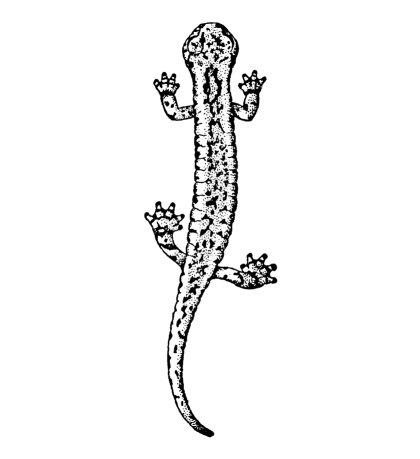
|
Mt. Lyell Salamander
| Online Library: | Title | Author | California | Geology | History | Indians | Muir | Mountaineering | Nature | Management |
Yosemite > Library > YNN > YNN 46(2) > Mystery of Hydromantes >
Next: Washington Burn • Contents • Previous: Lightning and The Landscape
Mt. Lyell Salamander |
by Sandy Dengler
Lurking about the springs and seeps of the Sierra high country, cowering in the crevices of exfoliating slabs, the Mt. Lyell salamander lives out his days under a little cloud of mystery. He has chosen as his home a climate inhospitable to most salamanders — he occurs at elevations of from 4,000 to 11,000 ft. Cold-blooded, he must derive heat from his surroundings and he must have a constantly damp environment to keep his skin moist. But that’s not the mystery.
He achieves a length of 2 or 3 inches, and his smooth, clammy skin is a blotchy granite color. His globby, mushroom-shaped tongue is attached to a long, thin stalk so nimble he can flick it out one-third of his body-length. His toes, four on the front feet, five on the back, are webbed, although his life-style does not include swimming. But that’s not the mystery either.
The Mt. Lyell salamander’s scientific name is Hydromantes platycephalus (hydro = water, mantis = fortune-teller or diviner, platy = flat, cephalos = head), and true enough, he has a noticeably flat head. The genus Hydromantes contains five species, but they are so closely similar that they are all considered a single species in a monotypic genus by some taxonomists.
Our own little flat-head lives in a narrow high-Sierra belt extending from Sonora Pass south to Twin Lakes in Sequoia National Park. His two close California relatives live, respectively, on the south flank of Mt. Shasta and in a tiny area near Briceburg where Bear Creek empties into the Merced. The fourth species occurs in the Alps of Europe and the fifth on the island of Sardinia, in the Mediterranean west of Italy.
This strange little genus is a member of the strange big family Plethodontidae (plethys = plenty, dens = teeth), whose members lack lungs (they breath through their skin and mouth lining). And here comes the mystery.
Every one of the plethora of Plethodonts lives in North or South America except two — those close European cousins of our Mt. Lyell salamander. The mystery emerges. How did those two little amphibians, the only lungless salamanders outside the Western Hemisphere, end up half a globe away from their nearly identical relatives?
A mystery by definition has no solution and this is a true mystery, for the problem remains unsolved. While scholars puzzle and debate, H. platycephalus continues quietly in his way, never dropping names about his continental cousins, shy and unassuming in the midst of an international enigma.
How’s that for true humility?! Let’s hear it for our own Mt. Lyell salamander!
Next: Washington Burn • Contents • Previous: Lightning and The Landscape
| Online Library: | Title | Author | California | Geology | History | Indians | Muir | Mountaineering | Nature | Management |
http://www.yosemite.ca.us/library/yosemite_nature_notes/46/2/hydromantes.html